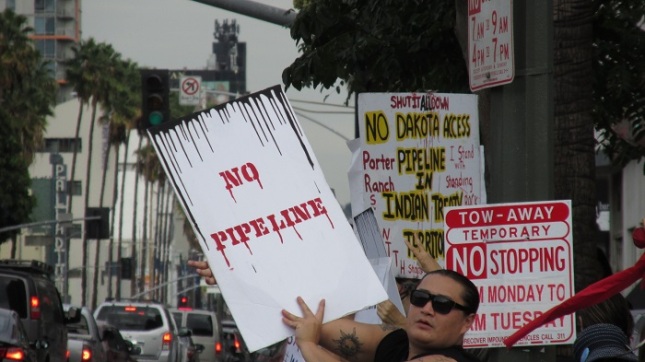If you haven’t heard about the protests by Native Americans against the Dakota Access Pipeline (DAPL), don’t feel bad. A lot of people haven’t gotten the news because the mainstream media was slow to report the story, and still isn’t giving it the attention it deserves. That’s why a group of Indian activists showed up in front of CNN’s offices on Sunset Blvd. on Saturday to make their voices heard.
To give you a quick update, Energy Access Partners (EAP) is pushing for the construction of a pipeline which would carry crude oil from the Bakken fields in North Dakota and Montana down to South Dakota, Iowa and Illinois. The Standing Rock Sioux and other Indian tribes are fighting the project, citing damage to sacred grounds and the potential for contamination of the Missouri River if the pipeline should rupture.
I don’t know the area and my knowledge of Native American religion is almost non-existent, so I won’t comment on the first claim. But it doesn’t take much more than common sense to realize that concerns about a possible rupture and massive environmental damage are absolutely valid. EAP claims that the pipeline would be safe, but just last month there was a spill in Alabama which saw the release of over 300,000 gallons of fuel. A link to the story in The Guardian is below. Funny how the incident didn’t get much attention in the US.
Pipeline Rupture in Alabama from The Guardian
And Californians will remember the pipeline leak earlier this summer which spilled 30,000 gallons of crude.
Oil Spill in California from Alternet
But let’s cut to the chase. Pipeline accidents happen all the time. Here’s a list from Wikipedia documenting hundreds that have happened just in the US since 2000. Many of them are small, with no significant damage to life or property, but the list contains a number of major incidents.
List of US Pipeline Accidents Since 2000 from Wikipedia
The petroleum industry keeps saying these accidents won’t happen, yet somehow they keep happening, and sometimes the damage to the environment is severe. What’s worse, when there is a disaster, the oil companies do everything they can to deny responsibility, and spend years in court fighting to reduce their liability.
EAP claims that the pipeline will promote energy independence for the US, but really they’re just feeding the country’s addiction to oil. The best way to foster energy independence is to reduce our use of fossil fuels. A huge body of evidence points to the conclusion that our reliance on fossil fuels is causing the climate to change. Glaciers are disappearing, the snowpacks are receding, and the polar caps are melting. And EAP wants to build another pipeline to boost our domestic oil supply? It’s obvious they just don’t give a damn.
I spoke to Lydia Ponce of the American Indian Movement (AIM), Southern California. She talked about the multiple incidents where police have used force against the protesters at Standing Rock. She also pointed out that the DAPL is just the latest episode in this country’s long history of allowing big business to exploit land and resources at the expense of native people. It’s actually been going on since the US was founded. Is it ever going to stop?
If you want to support the Indian communities that are fighting the DAPL, contact your elected officials now. Let Congress and the President know that we can’t afford the risks this pipeline poses, and we can’t afford to let oil companies continue to poison our water and our skies.
Click the link below to find out how to contact your elected officials.






